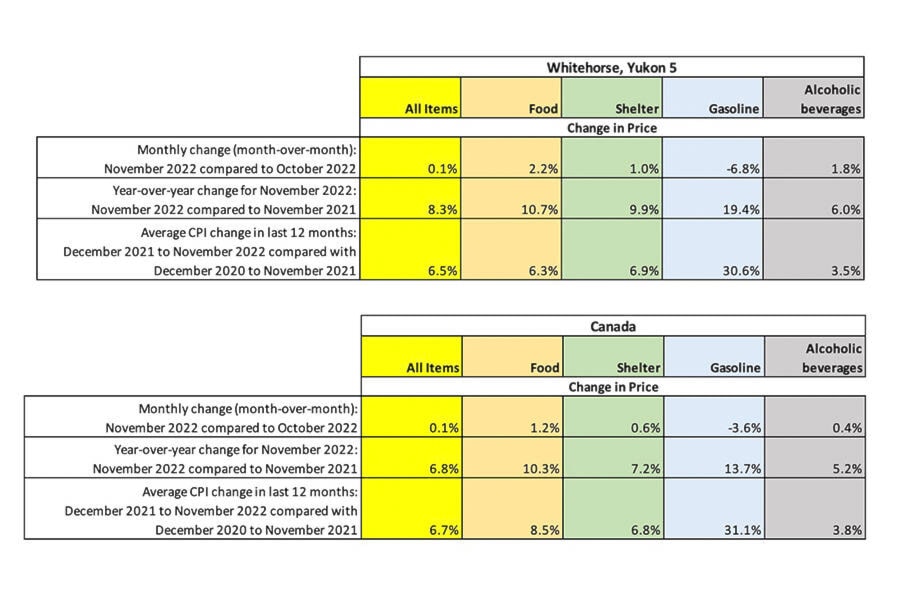The price of things Yukoners depend on keeps going up. The latest reports on Canada’s consumer price index (CPI) were released Dec. 22 by Statistics Canada.
In the North, the CPI only pertains to the major population centres of Whitehorse, Yellowknife and Iqaluit.
The Yukon Bureau of Statistics provided the News with summary charts that compare Whitehorse prices in four categories — food, shelter, gasoline and alcohol — to the rest of Canada. These items compare November 2022 to the previous month, the previous year, and calculate the average increase from 2020. These categories are not exhaustive, but affect most people in the territory.
For Whitehorse, it looks like everything is up again this month, with the welcome exception of the price of gasoline which dropped in Whitehorse by 6.8 per cent with residents here getting greater relief than others across Canada where the drop pegged in at 3.6 per cent.
This is a small reprieve — though gasoline fell over the last month, it had gone up by 19.4 per cent over the last year and has averaged a 31 per cent increase in both Canada and in Whitehorse since 2020.
Food costs have risen similar amounts in Whitehorse as they have in southern Canada coming in around 10.5 per cent over the last year. However, since 2020, the 6.3 per cent increase in the price of food in Whitehorse is less than what has been experienced in southern Canada with food costs there averaging an 8.5 per cent increase. Whitehorse may catch up though, having seen a 2.2 per cent increase since October 2022, whereas Canada’s food index increased a full percentage point lower at 1.2 per cent over the same period.
Over the last year, rising shelter costs in Whitehorse have risen 9.9 per cent compared to Canada which saw a 7.2 per cent increase. Over time, since 2020 the average increase has remained steady between the two areas at 6.8 per cent. Shelter costs include not just rent, but things like heating oil costs as well.
The alcohol category includes not just alcoholic beverages, but recreational cannabis and tobacco products. Prices in that category have only risen half as much as other areas. For example, while food and shelter have increased 10 per cent in the last year, alcohol increases were almost half of that. Since 2020 alcoholic beverages in both Whitehorse and Canada have averaged about a 3.6 per cent increase. The higher month-over-month increase in Whitehorse in December reflects Yukon Liquor Corporation’s updated wholesale and retail prices which went up Nov. 1, resulting in a 1.8 per cent increase, compared to only 0.4 per cent in Canada.
Looking at the full consumer price indexes for Whitehorse and Canada, the month-over-month change was miniscule for both, but not so over the last year. From November 2021 to November 2022, Whitehorse’s overall CPI came in at 8.3 per cent higher when compared to Canada’s at 6.8 per cent. However, since 2020 the average increase is similar — around 6.6 per cent — in both Whitehorse and Canada, leveling things out.
Zane Hill, a spokesperson from Yukon Bureau of Statistics explained that Canada experienced price increases before Whitehorse, but that since July the year-over-year increases have been higher in Whitehorse than for the rest of the country. Each month forward will be carefully watched to see when the pattern turns.
Contact Lawrie Crawford at lawrie.crawford@yukon-news.com
